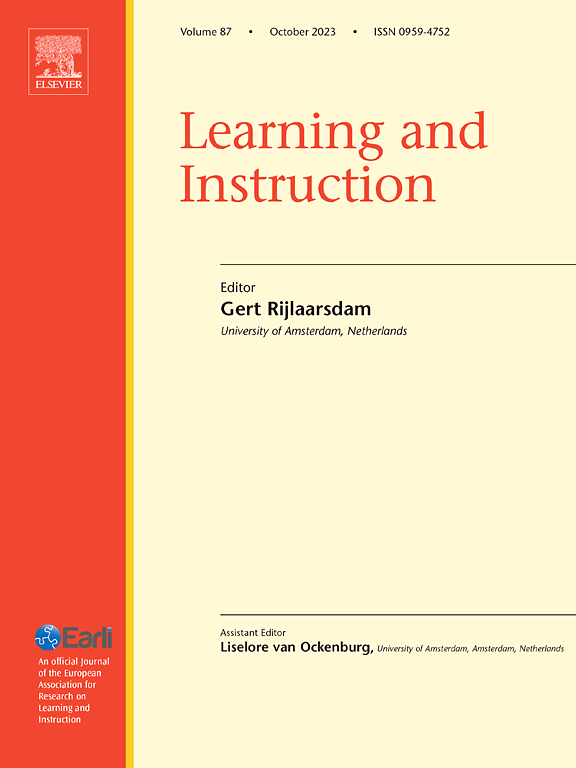Enhancing student academic performance in middle school classrooms by fostering engagement motivation through intelligent assessment of teacher praise emotional intensity
IF 4.9
1区 教育学
Q1 EDUCATION & EDUCATIONAL RESEARCH
引用次数: 0
Abstract
Background
Teacher praise is a powerful tool for enhancing student learning and managing behavioral challenges. However, existing methods for assessing teacher praise are overly simplistic, typically only relying on the frequency of behavioral special praise (BSP) to judge its effectiveness. Teacher praise serves as a means of conveying emotion, we categorized it according to emotional intensity. This approach seeks to examine how enhancing the intensity of praise influences student learning.
Aimed
The core research objectives are: (1) to explore the classification of praise intensity; (2) to investigate whether the GPT tool can effectively influence teachers' praise intensity; and (3) to examine the direct and indirect effects of changes in praise intensity on student academic performance.
Method
This study developed a praise intensity recognition assistant using GPT-3.5. A praise dataset was constructed and fine-tuned, achieving an accuracy of 95 %, demonstrating effective recognition. However, detecting and enhancing praise intensity remains a challenge.
Sample
20 teachers and 523 students participated in an intervention experiment focusing on praise intensity. Over a three-month period, we used this tool to observe whether improvements in teacher praise intensity affected student academic performance and learning behavior.
Result
Findings revealed that while student academic performance showed no significant improvement, student engagement notably increased.
Conclusion
Student engagement acted as a mediator, indicating an indirect link between teacher praise intensity and academic performance. This study underscores the indirect influence of enhanced praise intensity facilitated by GPT, highlighting the crucial role of student engagement in this process.
通过对教师表扬情绪强度的智能评估,培养学生的投入动机,提高中学生的学习成绩
背景:教师表扬是促进学生学习和应对行为挑战的有力工具。然而,现有的评价教师表扬的方法过于简单,通常只依靠行为特殊表扬(BSP)的频率来判断其有效性。教师表扬是一种传递情感的手段,我们根据情感的强弱对其进行了分类。这种方法旨在研究提高表扬的强度如何影响学生的学习。研究的核心目标是:(1)探索表扬强度的分类;(2)调查GPT工具是否能有效影响教师的表扬强度;(3)考察表扬强度变化对学生学业成绩的直接和间接影响。方法利用GPT-3.5开发表扬强度识别辅助工具。构建了一个赞美数据集并进行了微调,准确率达到95%,证明了有效的识别。然而,检测和提高表扬强度仍然是一个挑战。样本20名教师和523名学生参加了以表扬强度为重点的干预实验。在三个月的时间里,我们使用这个工具来观察教师表扬强度的提高是否会影响学生的学习成绩和学习行为。结果调查结果显示,学生的学习成绩没有明显改善,但学生的参与度明显提高。结论学生敬业度在教师表扬强度与学业成绩之间起中介作用,表明教师表扬强度与学业成绩之间存在间接联系。本研究强调了GPT促进的表扬强度增强的间接影响,强调了学生参与在这一过程中的关键作用。
本文章由计算机程序翻译,如有差异,请以英文原文为准。
求助全文
约1分钟内获得全文
求助全文
来源期刊

Learning and Instruction
Multiple-
CiteScore
11.30
自引率
4.80%
发文量
109
期刊介绍:
As an international, multi-disciplinary, peer-refereed journal, Learning and Instruction provides a platform for the publication of the most advanced scientific research in the areas of learning, development, instruction and teaching. The journal welcomes original empirical investigations. The papers may represent a variety of theoretical perspectives and different methodological approaches. They may refer to any age level, from infants to adults and to a diversity of learning and instructional settings, from laboratory experiments to field studies. The major criteria in the review and the selection process concern the significance of the contribution to the area of learning and instruction, and the rigor of the study.
 求助内容:
求助内容: 应助结果提醒方式:
应助结果提醒方式:


